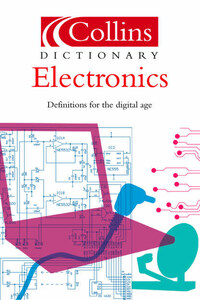The first edition of this dictionary was published in 1988, and the vast changes in Electronics since then are reflected by the larger size of this volume and the number of new terms and illustrations that have been added. In addition, I have taken the opportunity to recast the book in accordance with what I believe to be its main objectives.
A dictionary, above all, should provide an easy and rapid explanation of an unfamiliar term. A dictionary is not a textbook, so that an academic explanation is totally inappropriate, and for some abbreviations all that is needed is an explanation of the term, some of which need no elaboration (like POTS, meaning plain old telephone service). Above all, the dictionary entry should point out the general application of an unfamiliar term and its relationship to other parts of Electronics knowledge. I hope that I have achieved a good balance between the brief but inadequate and the verbose but incomprehensible. Some unavoidably academic topics are dealt with by referring the reader to a suitable textbook.
Although the foundations of electronics were laid in the late nineteenth century, the technology that we know as electronics is very much a product of the twentieth century, and the most rapid development of electronics has occurred in the years following the 1950s. Prior to that time, the word electronics had not been coined and the topics that we now consider as being part of electronics were then classed as part of radio engineering. Electronics has changed from being a development of radio engineering into an all-pervading subject in its own right, spawning various subdivisions and tangential topics as its growth exceeded that of any other engineering science. The rapid rise in the use of electronic devices has been brought about by the ubiquitous silicon crystal and the integrated circuit, products of the years since the Second World War. The integrated circuit itself was a by-product of the space race, one whose effect has been much further-reaching than the landing of a man on the moon.
As happens with any science that has been the subject of a rapid expansion, explanations and definitions have lagged behind the development of the technology. Each new development has brought with it a huge quantity of new terms, some of them slang words which have vanished almost as soon as they appeared, others of lasting value, and a few that, like feedback, have been assimilated into everyday English, though usually in an incorrect sense. Although the rate of growth of electronics has not really abated, the flow of new terms has been reduced to a level at which it becomes easier to take stock and select which terms are of lasting use and which were transient. There are still dictionaries which present slang words of the Second World War period as if they were a part of modern-day electronics; in contrast, the present volume is an attempt to define and explain the terms which I believe to be relevant to modern electronics. This now includes much (such as telephony) that once was regarded as separate from electronics, and new domestic devices such as the DVD recorder that were only being dreamt of at the time when the first edition was being prepared.
The book is intended to cater for anyone who needs to know the definitions of electronics terms. This of course includes the student, whether at school or in the early years of a university, polytechnic, or technical college course, but it is important to remember the needs of the non-specialist. To an ever-increasing extent, electronic devices and methods are impinging on studies that at one time would have appeared to be unlikely users of such devices. From archaeology to music, from medicine to navigation, electronic measurements and methods now need to be understood by students and practitioners of subjects that appear to have very little in common. The need for, and use of, electronics now transcends all the artificial divisions of subject matter, and makes a dictionary of electronics that is expressed in plain language a necessity rather than a luxury. Even the student of Electronics will have need to look up terms that are unfamiliar because the breadth of the subject makes it impossible to be aware of all its ramifications.
This book has therefore been designed with more than the needs of the traditional electronics student in mind. Each explanation is couched in accessible terms, avoiding the use of mathematics except where a note on the mathematical aspect of a topic is necessary as a reminder to the prospective designer as distinct from the user of electronics. The form of the dictionary has been set out so as to make it easier to find an explanation of a device or principle under one heading rather than requiring the user to flit from one heading to another, picking up pollen-fragments of learning from each. Additionally, cross references (indicated by SMALL CAPITAL LETTERS) guide the user to related entries. I am most grateful to Edwin Moore, of HarperCollins Publishers, for his unstinting efforts in working this book into its final form from the material on CD-R disc, for it is his efforts that have made this a readable and usable dictionary








